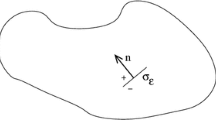Abstract
We apply to edge detection a recently introduced method for computing geometric structures in a digital image, without any a priori information. According to a basic principle of perception due to Helmholtz, an observed geometric structure is perceptually “meaningful” if its number of occurences would be very small in a random situation: in this context, geometric structures are characterized as large deviations from randomness. This leads us to define and compute edges and boundaries (closed edges) in an image by a parameter-free method. Maximal detectable boundaries and edges are defined, computed, and the results compared with the ones obtained by classical algorithms.
Similar content being viewed by others
References
A.S. Abutaled, “Automatic thresholding of gray-level pictures using two-dimensional entropy,” Comp. Vision, Graphics and Image Processing, Vol. 47, pp. 22–32, 1989.
J. Canny, “A computational approach to edge detection,” IEEE Trans. Pattern Anal. Machine Intell., Vol. 8, No. 6, pp. 679–698, 1986. Edge Detection 283
V. Caselles, B. Coll, and J.-M. Morel, “A Kanisza programme,” Progress in Nonlinear Differential Equations and their Applications, Vol. 25, pp. 35–55, 1996.
L. Davis, “A survey of edge detection techniques,” Comp. Graphics and Image Processing, Vol. 4, pp. 248–270, 1975.
R. Deriche, “Using Canny's criteria to derive a recursively implemented optimal edge detector,” Int. J. of Comp. Vision, Vol. 1, No. 2, pp. 167–187, 1987.
A. Desolneux, L. Moisan, and J.-M. Morel, “Meaningful Alignments, in Proceedings of SCTV'99. Electronic publication available at http://www.cis.ohio-state.edu/~szhu/SCTV99.html, 1999.
A. Desolneux, L. Moisan, and J.-M. Morel, “Maximal meaningful events and applications to image analysis,” preprint CMLA (http://www.cmla.ens-cachan.fr), 2000.
R.O. Duda and P.E. Hart, Pattern Classification and Scene Analysis, Wiley, 1973.
S. Geman and D. Geman, “Stochastic relaxation, Gibbs distributions and the Bayesian restoration of images,” IEEE Trans. Pattern Anal. Machine Intell., Vol. 6, pp. 721–741, 1984.
G. Guy and G. Medioni, “Inferring global perceptual contours from local features,” Int. J. of Comp. Vision, Vol. 20, No. 1, pp. 113–133, 1996.
J. Huang and D. Mumford, “Statistics of natural images and models,” Comp. Vision and Pattern Recognition,Vol. 1, pp. 541–547, 1999.
M. Kass, A. Witkin, and D. Terzopoulos, “Snakes: Active contour models,” Int. J. of Comp. Vision, Vol. 1, No. 4, pp. 321–331, 1988.
D. Lowe, Perceptual Organization and Visual Recognition, Kluwer Academic Publishers, The Netherlands, 1985.
A. Martelli, “Edge detection using heuristic search methods,” Comp. Graphics Image Processing, Vol. 1, pp. 169–182, 1972.
P. Monasse, “Représentation morphologique d'images numériques et aplication au recalage d'images,” Thèse de doctorat, Univ. Paris Dauphine, 2000.
J.-M. Morel and S. Solimini, Variational Methods In Image Segmentation, Birkhäuser, 1994.
D. Mumford and J. Shah, “Boundary detection by minimizing functionals,” in IEEE Conf. on Comp. Vision and Pattern Recognition, San Francisco, 1985, pp. 22–25.
T. Pavlidis, “A critical survey of image analysis methods,” in IEEE Proc. of the 8th Int. Conf. on Pattern Recognition, Paris, 1986, pp. 502–511.
T. Pun, “Entropic thresholding, a new approach,” Comp. Graphics and Image Processing, Vol. 16, pp. 210–239, 1981.
A. Rosenfeld and M. Thurston, “Edge and curve detection for visual scene analysis,” IEEE Trans. Comput., Vol. 20, pp. 562–569, 1971.
M. Wertheimer, “Untersuchungen zur Lehre der Gestalt, II,” Psychologische Forschung, Vol. 4, pp. 301–350, 1923.
J.S. Weszka, “A survey of threshold selection techniques,” Comp. Graphics and Image processing, Vol. 7, pp. 259–265, 1978.
S.W. Zucker, “Region growing: Childhood and Adolescence (Survey),” Comp. Graphics and Image Processing, Vol. 5, pp. 382–399, 1976.
T.M. Cover and J.A. Thomas, Elements of Information Theory, Wiley Series in Telecommunications, Viley, NY, 1991.
K.S. Fu and J.K. Mui, “Asurvey on image segmentation,”Pattern Recognition, Vol. 13, pp. 3–16, 1981.
R.M. Haralick and L.G. Shapiro, “Image segmentation techniques,” Comp. Vision Graphics and Image Processing, Vol. 29, pp. 100–132, 1985.
G. Kanizsa, La Grammaire du Voir, Editions Diderot, arts et sciences, 1994.
Y. Leclerc, “Constructing simple stable descriptions for image partitioning,” Int. J. of Comp. Vision, Vol. 3, pp. 73–102, 1989.
W. Metzger, Gesetze des Sehens, Waldemar Kramer, Frankfurt Germany, 1975.
P. Parent and S.W. Zucker, “Trace inference, curvature consistency and curve detection,” IEEE Trans. Pattern Anal. Machine Intell., Vol. 2, No. 8, pp. 823–839, 1989.
J. Rissanen, “A universal prior for integers and estimation by Minimum Description Length,” Annals of Statistics, Vol. 11, No. 2, pp. 416–431, 1983.
D.L. Ruderman, “The statistics of natural images,” Network Computation in Neural Systems, Vol. 5, pp. 517–548, 1994.
A. Sha'Ashua and S. Ullman, “Structural saliency: The detection of globally salient structures using a locally connected network,” in Proceedings of the 2nd Int. Conf. on Comp. Vision, 1988, pp. 321–327.
A.P. Witkin and J.P. Tenenbaum, “On the role of structure in vision,” Beck, Hope and Rosenfeld, Eds. (New York: Academic Press), pp. 481–543, 1983.
Author information
Authors and Affiliations
Rights and permissions
About this article
Cite this article
Desolneux, A., Moisan, L. & Morel, JM. Edge Detection by Helmholtz Principle. Journal of Mathematical Imaging and Vision 14, 271–284 (2001). https://doi.org/10.1023/A:1011290230196
Issue Date:
DOI: https://doi.org/10.1023/A:1011290230196




